Also on:
https://twitter.com/i/status/1657079451954434048https://stevekirsch.substack.com/p/very-large-cleveland-clinic-studyhttps://www.medrxiv.org/content/10.1101/2022.12.17.22283625v1.full.pdf"
Very large Cleveland Clinic study shows more vaccines make you more likely to get COVIDThey lied to you. Even "Debunk the Funk" couldn't debunk this result. Uh oh.
Steve Kirsch
Jan 19, 2023
Executive SummaryStudy done at the prestigious
Cleveland Clinic, rated #2 best hospital in the world by Newsweek, shows people with more jabs were more likely to get COVID than people with fewer jabs. In other words,
we now know that the vaccines had the opposite effect from what we were told.Here is a direct quote from
the paper which makes this crystal clear:
The risk of COVID-19 also varied by the number of COVID-19 vaccine doses previously received.
The higher the number of vaccines previously received, the higher the risk of contracting COVID-19 (Figure 2).
This is directly measured.
They even repeated it repeated again:
The multivariable analyses also found that…
the greater the number of vaccine doses previously received the higher the risk of COVID-19.The 30% reduction for the booster determined in the paper is
not measured. It is
calculated based on adjusting for the all the various variables using a Cox regression analysis. They didn’t provide the source data and didn’t respond to to emails. I would have liked to have seen it.
In particular, the paper says, “Individuals were considered bivalent vaccinated 7 days after receipt of a single dose of the bivalent COVID-19 vaccine.” This is a problem if you want an accurate measurement because the authors erroneously assumed that the vaccine could not make you more likely to be infected in the 7 days after the injection. This could account for their 30% efficacy number. But we are not allowed to know whether it would have an impact or not because the authors aren’t making the data for the bivalent booster recipients available or responding to email inquiries.
There is no room for ambiguity on the dose vs. infection rate.
The paper also cited two other large studies which found the same thing: that more vaccines can increase the likelihood of infection. For example, the Qatar paper found a 47% increased likelihood of infection if you had 3 doses compared to 2 doses. The other paper found a 54% higher infection rate for those who got 2 doses vs. 1 dose. See a pattern?
There’s a fourth study. Pfizer found the same thing in their trials as well, and notified the FDA of this in September 2021:
people who were vaccinated with two jabs were more than 2X more likely to get COVID than those who were unvaccinated. The Cleveland Clinic study merely confirmed this result.
As far as debunking the dose-infectivity relationship,
there was ZERO evidentiary support cited in any of the attacks. A great attack would be to say that the authors have written 10 papers and 1 out of 10 was later found to be erroneous. Then the apriori probability of this paper being right would only be 90%. But none of the attacks came with any evidentiary support. For example, they said “it was only done for working age healthcare workers” but failed to cite a single study showing that results from that population could not be extrapolated to the general population, especially in light of the fact that two-thirds of the confirming studies confirmed the effect in the general population.
In short, the attacks were anemic in their evidentiary support.Bottom line:
The vaccines actually made the pandemic worse. Nobody has been able to refute the paper with a credible argument supported by data.
_________________
Forum admin note: I would imagine that few places demonstrated this more clearly than Japan:
https://www.covid-19forum.org/index.php?topic=1668.0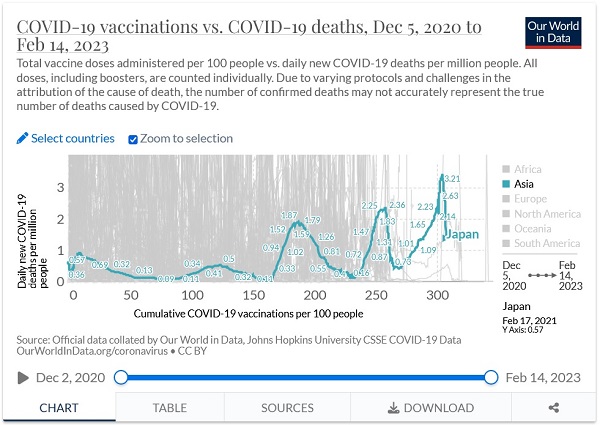
_________________
IntroductionHere’s Figure 2 from the
Cleveland Clinic study (posted December 19, 2022) which looked at 51,011
working-age people who work at the Cleveland Clinic who have various vaccination status.
People with more jabs were more likely to get COVID than people with fewer jabs.
They started the clock for everyone at the same time: on the day the bivalent COVID-19 vaccine first became available to employees.
As you can see, people with more shots were more likely to get COVID and the differences were statistically significant.
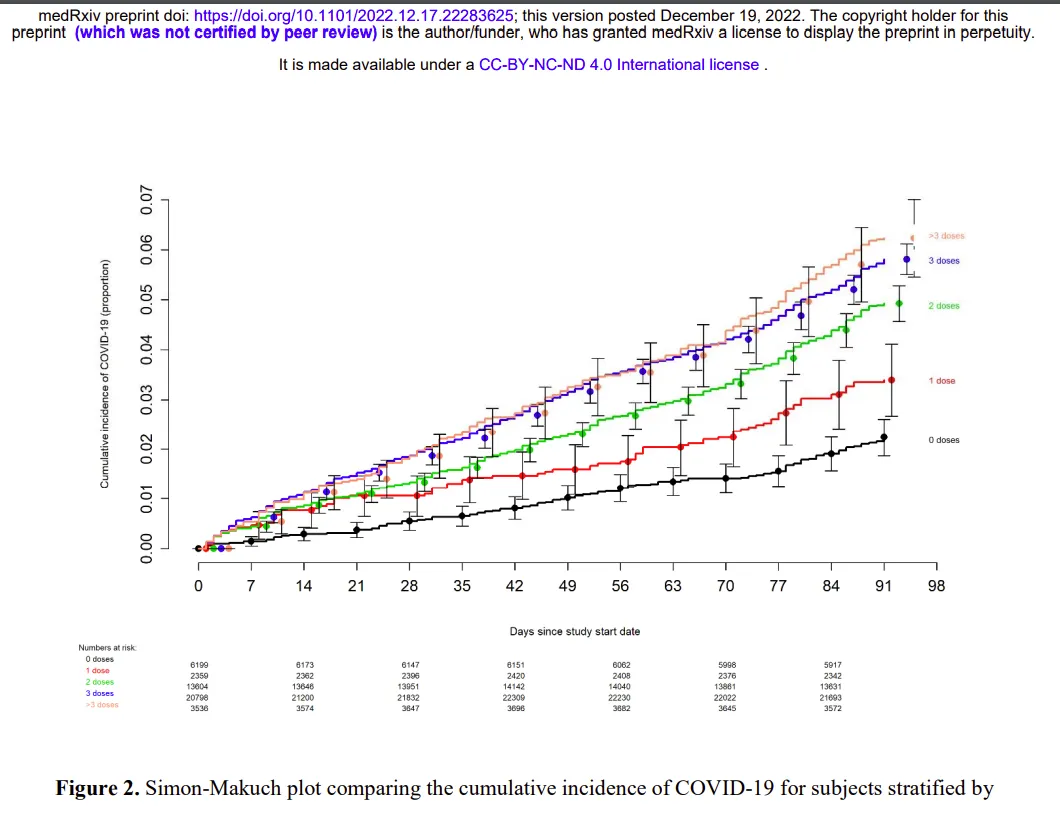
And the kicker was they said that
they were not the only study to find this effect where the more vaccines you got, the greater the risk of getting COVID. They cited two other papers which found the same thing. They concluded that there is a big problem here:
“it is important to examine whether multiple vaccine doses given over time may not be having the beneficial effect that is generally assumed.”Also, check out the adjusted HR values in Table 2.
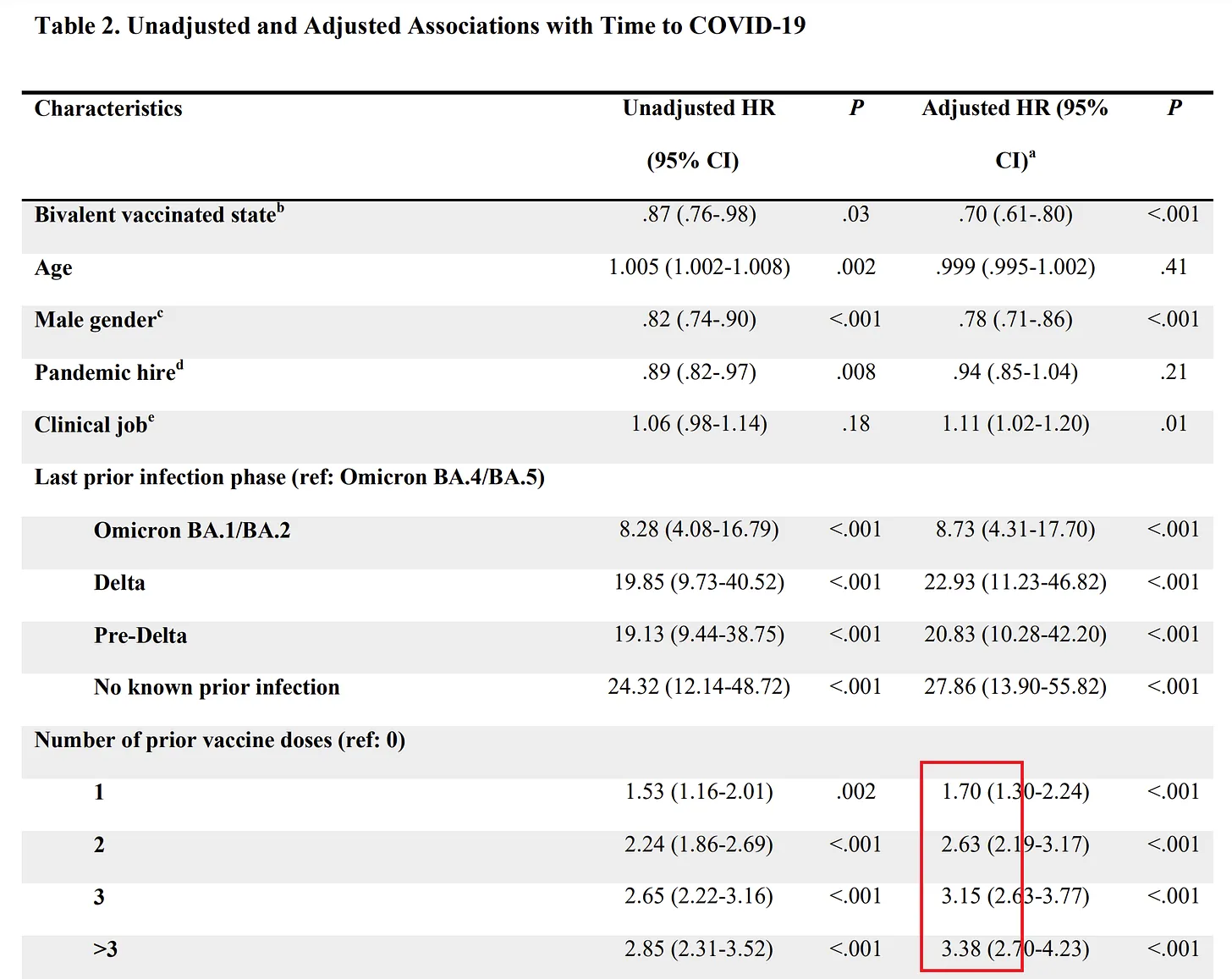
For example, a hazard ratio (HR) of 1.7 means you are 1.7X more likely to be infected with COVID than an unvaccinated person.
The authors say that the results were only for the population tested (healthcare workers of working ages) and shouldn’t be extrapolated to younger people or older people (since they weren’t part of the study). Sure, but it’s supposed to work in all people!!! Working age healthcare workers were NEVER carved out as exceptions by anyone.
In fact, just to make things more clear, after the study came out,
every healthcare practice and hospital in the entire world should have done a reverse mandate: that you’d be fired if you got vaccinated since the study showed that you were at increased risk. I’m not aware of this happening anywhere in the world. Did I miss that?
The original Pfizer study showed you were at least 2x more likely to get COVID if you got the 2 shots
Most people didn’t read the September 17, 2021 FDA briefing document so let me highlight the top of page 22 for you:
Image
So you were 70.3/51.6=36% more likely to get COVID if you got the vax early on vs. those in the placebo group (who later got the vax and who spent only half the time in the vaccinated state).
Because the numbers were so large, the difference between the groups is highly statistically significant (over 4 sigma).
But let’s do the math because the placebo group spent roughly half the time in the vaccinated state as the original vaxxed group.
So for the original vaxxed group, for 1,000 persons, we got 70.3 cases over a year.
For the placebo group, we’ll simplify it and say they were unvaxxed for the first half the year and vaxxed for the second half. So in the second half, they got 35.15 cases and we know they got 51.6 cases, so the first half of the year they got 51.6-35.15 cases=16.45 cases.
So if we take 35.15/16.45=2.13, i.e., if you are doubly vaxxed, you are 2.13X more likely to be infected than an unvaxxed person.
Now look at the Cleveland Clinic study in Table 2 for the adjusted hazard ratio: 2.63 (with a minimum of 2.19). So the Pfizer results are not at all surprising and align well with the Cleveland Clinic study.
One user on Twitter claimed that the reason the cross-over group had fewer infections is because they were vaccinated more recently. That’s just wrong. One group was vaccinated for a mean of 9.8 months in the study period; the other group spent only 4.7 months in the same time period in the vaccinated state. For the rate calculation, the time period measured was the entire time; it was not a measurement of the infection rate in the final month. If the vaccine really worked, the original vaxxed group would have had fewer infections. They didn’t. It wasn’t even a close call.
The other argument would be is to ASSUME (without evidence) that the variants were more infectious in the second half of the time period so getting the vaccine then while it was “fresh” was protective whereas the people who got the vax early it had “worn off” after 4 months so that’s why there was a difference. But that’s clearly false as the data shows that the vaccine’s “inverse protection” is CONSTANT OVER TIME: the “curves” in Figure 2 are lines, they are not curved. And if the did curve ever so slightly over time, since the people who got vaxxed earlier had better protection, it argues that the vaxxed group should have been better protected during the infection wave in the second half, so it is completely opposite to what happened. In short, the more people try to explain the data with bogus hypotheses such as these, the more they discredit themselves. They are literally grasping at straws.
In short, Pfizer found the same effect as the Cleveland Clinic study and the FDA knew about it in September 2021 and of course said nothing to alert the public.
And last, but not least, there were just 3 cases of severe COVID. Isn’t it remarkable that all three cases were in the group that has been vaccinated for the longest amount of time? And it’s not because the vaccine “wears off” over time and there was a deadlier variant in early 2021. You can see that the risk of infection (the slope of the lines in Figure 2) looks very constant, i.e., the lines are straight and not curved.
The Cleveland Clinic study has now simply made all of this painfully obvious.
In short, the FDA knew in September 2021 that if you took 2 doses of the Pfizer vax that those people were twice as likely to be infected as the unvaccinated group.
The study confirmed: natural infection worksThe other revealing thing in the study is that natural infection (and
NOT vaccination status), did confer a benefit. In general, the more recently you were infected and recovered, the less likely you were to get COVID:

In short, natural immunity works and lowers your risk. COVID vaccines do the opposite and increase your risk of infection. Doctors should be ashamed of misleading their patients.
Here’s what the paper said … but those who chose not to follow the CDC’s recommendations on remaining updated with COVID-19 vaccination, and
one could reasonably expect these individuals to have been more likely to have exhibited higher risk taking behavior. Despite this,
their risk of acquiring COVID-19 was lower than those who received a larger number of prior vaccine doses. This is not the only study to find a possible association with more prior vaccine doses and higher risk of COVID-19. A large study found that those who had an Omicron variant infection after previously receiving three doses of vaccine
had a higher risk of reinfection than those who had an Omicron variant infection after previously receiving two doses of vaccine [21]. Another study found that receipt of two or three doses of a mRNA vaccine following prior COVID-19 was associated with a
higher risk of reinfection than receipt of a single dose [7].
We still have a lot to learn … and in addition to a vaccine’s effectiveness it is
important to examine whether multiple vaccine doses given over time may not be having the beneficial effect that is generally assumed.Attempts to debunk the studyNo one has been able to debunk this study with evidence.
For example, the
attempt by McGill to discredit the study is to claim
without any evidence that there must be some other factor that explains the consistent results in the study, the 2 other studies, and the Pfizer Phase 3 study. This is known as “
the hand-waving argument.” For example, there are 17,000 excess deaths for the COVID vaccine in VAERS. The hand-waving argument is “oh, that’s just because people are more aware of VAERS today and are reporting at 50X more frequently than before.” Such hand-waving arguments can be used to “discredit” just about anything.
Only if there is evidentiary support should such arguments be taken seriously. Did the person making the argument
provide data to back up their explanation? In the McGill article, there is absolutely no evidence whatsoever presented to justify that their “explanation.”
They didn’t even try. This is a common theme. When they resort to hand-waving attacks (no evidentiary support),
it’s a tacit admission that they lack any evidence to attack the results.The McGill attack also points out that the paper hasn’t been peer-reviewed. This is again a “catch-all” argument. If the paper is wrong, the reviewer should tell us what the mistake was. The reviewer is free to ask the authors clarifying questions. The McGill reviewer failed to point out a flaw and clearly never attempted to contact the authors about a problem with the paper.
The fact is that this paper likely got more peer review than 90% of the papers out there because
every pro-vax advocate was reviewing it to try to poke a hole in it because it is so counter narrative. The smart ones didn’t touch it because there is nothing to attack. Debunk The Funk’s “critique” was anemic.
So the fact that their best attack was a hand-waving argument and a generic “it’s not peer reviewed” is a tacit admission that they have no solid basis to dispute the results.
Some people attempt to claim that the paper confirms that vaccines work because it found a 30% risk reduction after vaccination as noted in Table 2.
However, that’s an overall relative risk reduction relative to where you were before the booster, not an absolute risk reduction compared to being unvaccinated. What matters to people is whether or not the vaccine is a net benefit. If most of the people who got the bivalent shot were multiply vaccinated and the bivalent booster reduced their risk by 30% for 60 days, they are still at a significant disadvantage compared to an unvaccinated patient.
The bottom line is that the paper makes it clear that the negative impact of additional shots is
much greater than the small and possibly temporary benefit of the bivalent booster. The benefit was measured over an average of just 45 days (which I’m estimating since it wasn’t disclosed) so
we don’t know the longer term benefit.Nor do we know if all subgroups had a benefit. That is all hidden from view.The authors
explicitly call out the very large dose-infection rate relation as a matter of great concern: We still have a lot to learn about protection from COVID-19 vaccination, and in addition to a vaccine’s effectiveness it is important to examine whether multiple vaccine doses given over time
may not be having the beneficial effect that is generally assumed.All of the “debunkers” ignore this acknowledgement that more vaccines are increasing the absolute risk of infection.
Others tell people that this study shows the opposite of what it plainly tells people. For example, check out the
replies to my Quora post where the people who disagree with my post are unable to explain the results Figure 2 and Table 2. They basically hope that nobody actually reads the paper and instead they tell people that the paper says the opposite of what it says without citing the paper.
Then they resort to ad hominem and/or gaslighting attacks instead of showing the “correct” (in their mind) interpretation of the data in the study. Or they refer to someone else’s work. The Quora post is a very clear example of a deliberate inverting of what the data says where the people doing this attempt to gaslight me. This is never going to work, but it may fool readers who can’t read a technical paper. It is really stunning because it is so clear what they are doing.
For example, Leo Miles, who has accumulated just 2 followers after 5 years on Quora, writes as if he is an authority on the Cleveland Clinic paper, yet he can’t cite anything in the paper. Instead, he must resort to other people’s interpretations (most likely because he doesn’t understand the paper). I asked him to show me a more credible study (larger number of patients and more credible researchers) that dispute the Cleveland Clinic paper and all he comes up with is the McGill hand-waving argument which doesn’t cite a more authoritative study. In short, he fails to deliver when asked to produce evidence.
John Campbell did a video on this study and
YouTube deleted it. That once again tells you that the study definitely doesn’t support the narrative and is evidence that Campbell is, once again, right over the target.
The pro-vaccine camp HATES this study because it goes against the narrative and they cannot attack it.
If the study proved their point that the vaccines work, they’d be praising it and not criticizing it at all! The fact checks would all point out how it proves their point.
Eugene Gu said that it wasn’t peer-reviewed! This is disingenuous as I’ve pointed out earlier.
Debunk the Funk created a YouTube video where he said that the start point was arbitrarily chosen and that
the y-axis was “not huge.” The y-axis is linear and the differences at day 91 are statistically significant. I’m serious he really said this. Listen at 1:08 in the video. This guy is a PhD who studied the paper carefully.
Then he said look at this other study which didn’t measure the same thing at all.
If you want to debunk the study, Mr. Funk, you need to explain how all 4 studies (the Cleveland Clinic study, 2 studies they cited, and the Pfizer results) were wrong and then show us a comparable study (top institution with a better methodology) that showed the opposite result.
This test was fair. Everyone started off at the same point in time, it’s the Cleveland Clinic employees who are regularly tested, and it’s all working age people. It’s real-world study. The sizes in the groups were sufficient to establish statistical significance of the result.
The pro-vax community hates this but as you can see from “Debunk the Funk”’s video, they cannot find a way to dispute it.
Oh, and he said the study wasn’t well designed. Wow. For the purposes of Figure 2, what was the DESIGN FLAW that they could have fixed? He doesn’t mention that.
The study is real world at the hospital. I don’t know what more they could have done, do you?
The elephant in the room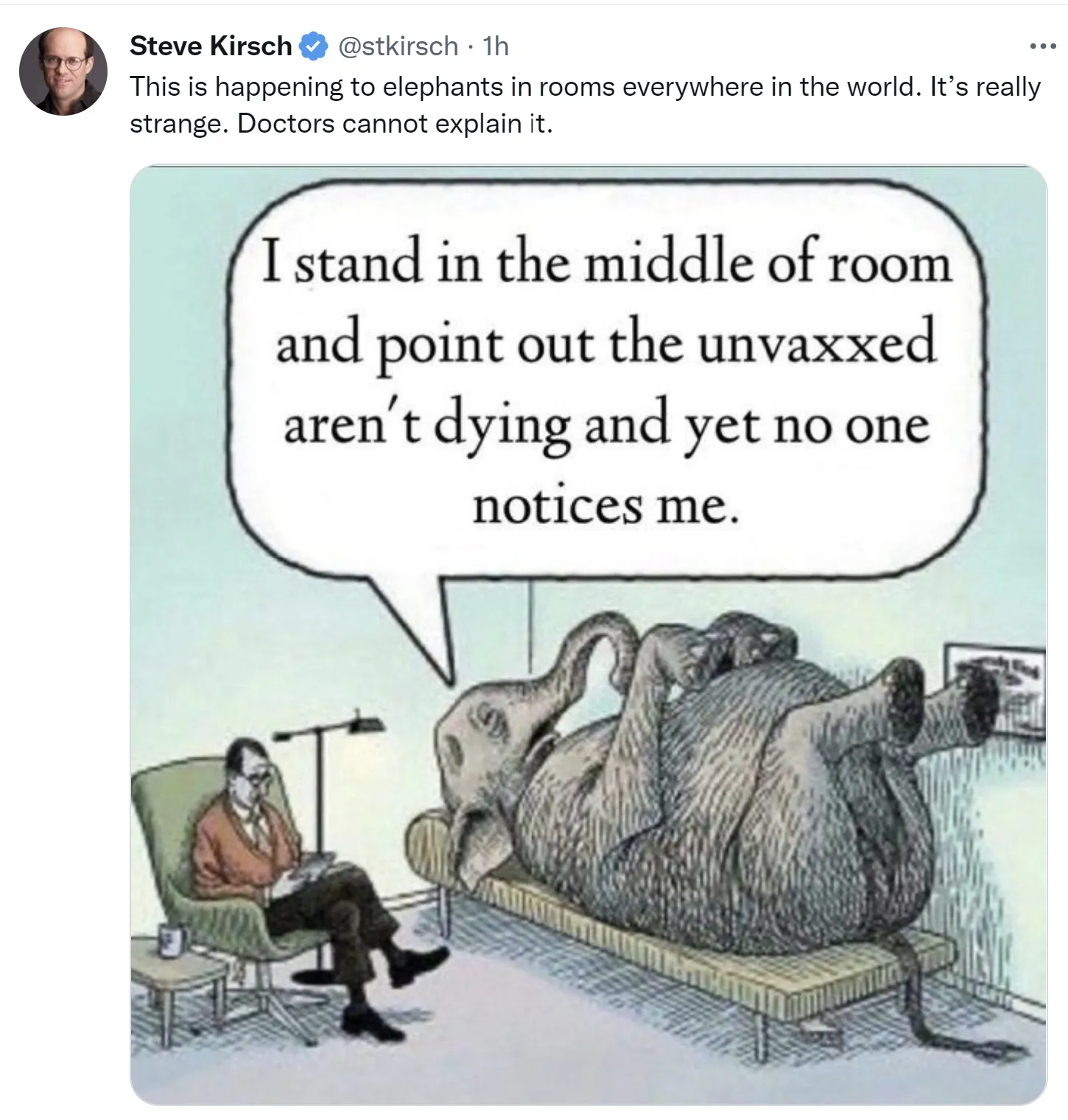 Mechanisms of action to explain this
Mechanisms of action to explain thisThere are many papers that explain why the shots make you more likely to get infected rather than less likely.
Dr. Mobeen did a good video on this a while ago.
Here’s
a recent article talking about class switching to IgG4 which also negatively impacts immunity. Note that the original paper that it references is written in a way so that it would get published (i.e., it says vaccination is great, but we should watch out for this…).Thank you to Alex Berenson
Alex Berenson wrote about the
Chinese study showing after 4 shots of the vaccine, your immune system is damaged and it’s not clear for how long. But it was in humanized mice, not people. You should read his post. This is important.
He wrote:
Mice who received more than four Covid vaccine jabs
had a collapse in their ability to fight the coronavirus, Chinese researchers have found.and
Last month, researchers at the Cleveland Clinic reported that they
had found “the higher the number of vaccines previously received, the higher the risk of contracting COVID-19." And last week a very large
French study reported that a second mRNA booster was
less effective than the first at every comparable time interval - and that after four months it actually raised the risk for infection compared to people who had not received it.
So other independent journalists are finding the same thing I’m seeing.
The final criticism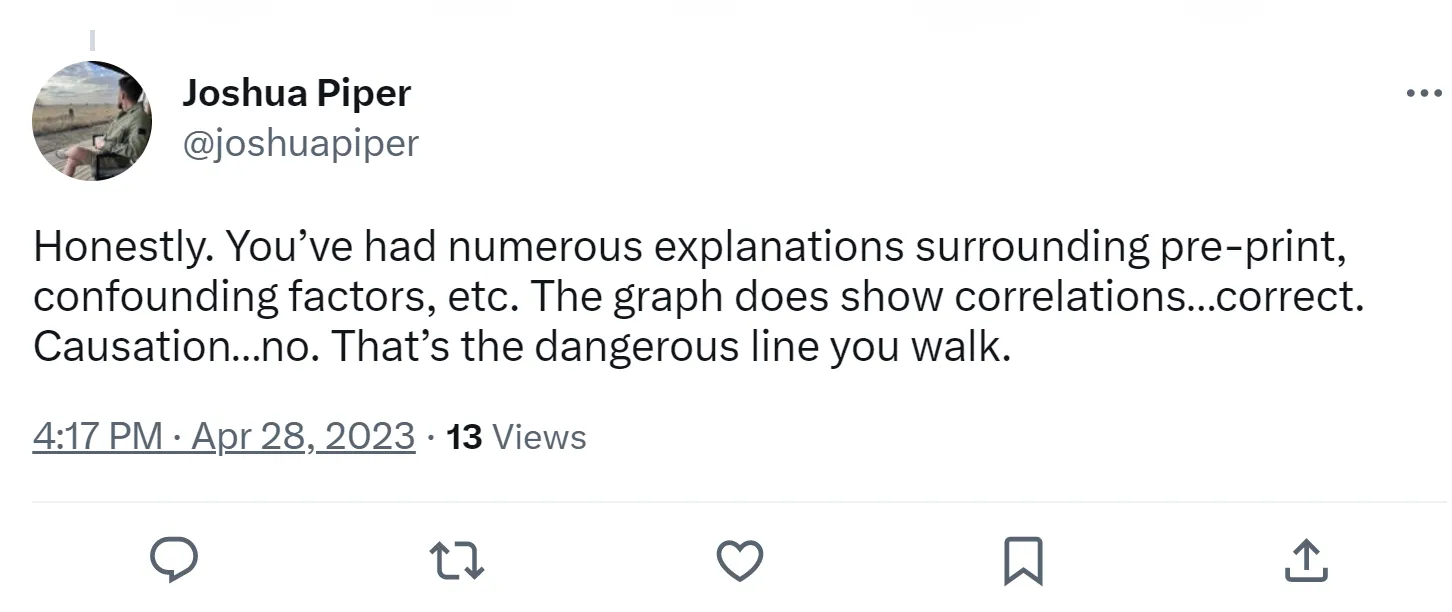
So he admits more vaccines are associated with higher rates of infection. But his hand-waving argument is correlation isn’t causation so you haven’t proved it.
That’s wrong. Dose dependency alone is sufficient evidence of causality to then have the precautionary principle of medicine shift the burden to Joshua to identify the “real” cause which is better correlated to the observations.
Demonstration of a dose-response relationship
is considered strong evidence for a causal relationship between the exposure and the outcome.In this case, we have something much stronger: a near-linear dose response relationship. As far as I know,
there are no counterexamples where there isn’t causality when this is observed.In addition,
all five Bradford Hill criteria (
there are only 5 for vaccines) are satisfied as well:
1.
Consistency: Fig 2 curves are consistent even though the data came from multiple locations. It wasn’t like at location A the vaccines made you less likely to be infected and at different locations they made it more likely. The paper mentioned two other studies showing the same dose response (more doses —> more infections).
2.
Strength: Fig. 2 and Table 2 show clear statistical significance and the error bars in both either don’t overlap or barely overlap.
3.
Specificity: The effect is specific to the dose (dose dependent).
4.
Temporal relation: Once you give the dose, you get moved to the next bucket and within 14 days, just by looking at the curves, you can tell how many vaccines a given group was given.
5.
Biologic plausibility: There are a preponderance of research papers talking about negative impacts to toll-like receptors, class switching, and more.
At this point, the precautionary principle of medicine shifts the burden to Joshua to provide a different explanation that is a better fit to the observations. For some reason, he’s been withholding that from public view.
So now that I’ve shown evidence in spades for causality, I asked him to either point out an error in what I wrote or produce a hypothesis that is a better fit to all the observed data.
He failed to do either.
My pollsThey
consistently show the more jabs, the worse the outcomes.For boosters, only 1 place out of 102 reported they were beneficial.
How will they explain that one? Can we see THEIR data?
The trials claimed the vaccines reduce your risk of COVID infection by 10X. It should be impossible to get the polling results I got.
Can we see “their” poll?
Even more data showing the vaccines make you more likely to get COVIDThe Walgreen’s data shows that it isn’t just healthcare workers who are more likely to get infected with more vaccines, it’s everyone:

This paper, published in a peer-reviewed journal, showed natural immunity had a 13X higher protective effect than vaccination. From Table 1 above, we might fairly estimate that natural immunity on average confers a 6.5X reduction in risk compare to the unvaccinated. This implies that the vaccine is increasing risk for the vaccinated over the vaccinated by 2X. More confirmation.
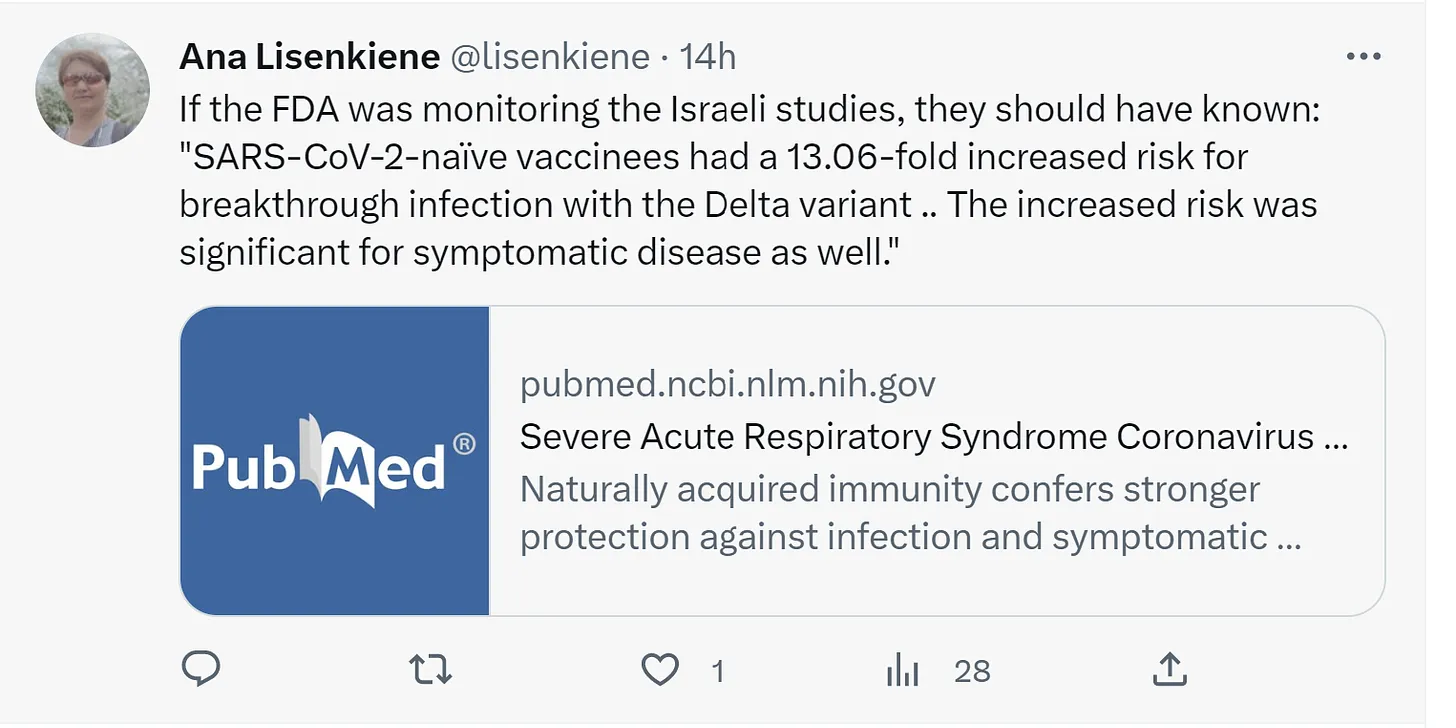 Summary
SummaryThe Cleveland Clinic study kills the narrative. The authors are pro-vaccine!
The result was clear: the more shots you get, the more likely you are to get COVID.
That’s why the study wasn’t covered by any mainstream media. And banned from YouTube.
And that’s why this study by top people at the Cleveland Clinic will never be published in the peer-reviewed scientific journals. Because that’s the way science works.
[edit add on 2-19-23] Drug Companies Test New Booster on Eight Mice and Zero Humans, FDA Approves It Anyway
With no efficacy or safety data, the agency is enthusiastically promoting a fifth COVID shot
https://www.tabletmag.com/sections/news/articles/pfizer-moderna-test-covid-booster-eight-mice-zero-humans-fda-approves-anywaySo why shouldn't a company that's making tens of billions of dollars while killing and permanently disabling millions of people with their first series of non-vaccines -
that had 42% greater all-cause mortality in their vaccine group than placebo group the first time around - believe they could get away with
testing the new jabs on 8 mice to be sufficient before rollout, for a toxin they hope to stick into another billion people? Yet their captured media self-proclaimed "fact-checkers" and compromised websites on the internet, actually defend this
questionable corporation!
https://duckduckgo.com/?q=comarity+tested+on+8+mice&t=h_&ia=webThe world has gone mad, with the U.S. leading the parade! [end edit]